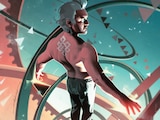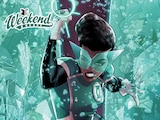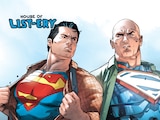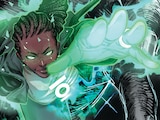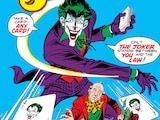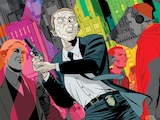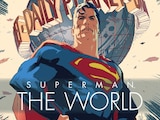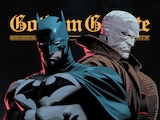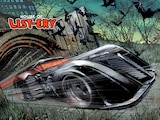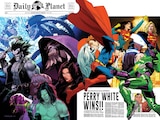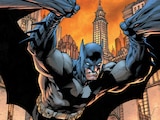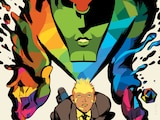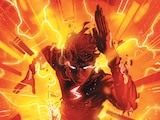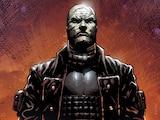Welcome to a new era of ASK…THE QUESTION. I’m Alex Jaffe, professional comic book expert and known, as ever before, to the DC Community as HubCityQuestion. As I have done for years past, I continue to be available to the public to answer any questions and mysteries you may have about the DC Universe, its makings and its environs, no matter how elementary or how obscure. The difference now is that my new home can be found in our DC Official Discord server, in the #ask-the-question channel, making me more widely available to a greater audience than ever before.
I’ve received hundreds of questions since the Discord launch just a scant few weeks ago, and I’ve done my best to address all of them in turn. I urge you to check out the Discord, if you haven’t already, for daily questions and answers as they come. But in the meantime, here are some of the highlight cases I’ve taken up in my new quarters. The format may be a bit different from past columns, but the objective’s the same. Let’s get some answers!

RexRebel asks:
Who was the first robot and/or android introduced in the DCU?
Answering this is tricky as early DC comics don't neatly fall into what we consider to be the "DCU" today...but I'm going out on a limb by calling it for Echo, a robotic foe of the Crimson Avenger in 1941's Detective Comics #49.
Azure asks:
What team has had the biggest roster in DC?
Probably the Green Lantern Corps. That’s a 7,200 member team.

P1k5 asks:
Is Terry McGinnis still canon in the main continuity?
That's a tricky question! From a certain perspective, yes. Terry's adventures in the future of the DC Universe continue to develop as recently as 2023's Batman Beyond: Neo-Gothic, exploring his Post-Bruce career.
However, by virtue of being a comic set in the future, the way the DC timeline works is that all future-set stories are possible futures. So, while the Batman Beyond comics represent the future of the DC Universe as we know it now, it may not be what actually comes to pass.
M asks:
What is the current canon reason for the extinction of Green Martians?
The Green Martians were eradicated by a psychic plague known as H'ronmeer's Curse, which swept through all the psychically linked minds of Martian society. Who set off the psychic plague and how it spread is something that's changed over the years, but the latest version of the story as seen in Steve Orlando's Martian Manhunter series is that collective fear of the curse itself is what made it strong enough to destroy the Martians.

Jurisdiction asks:
I know DC has done comic adaptations of many TV shows such as Chuck and Vampire Diaries. My question for you is just how many TV shows have DC (or any of its imprints) adapted into comics? What are they?
All right, let's see if we can do this. In the spirit of the examples you listed, I'm not including any comics based on internal DC series. Nor am I listing anthologies like Looney Tunes or Cartoon Network Block Party, which aren't dedicated to any specific show. With that in mind, here's a list for you:
- Animaniacs
- The Avengers (Batman '66 Meets Steed and Mrs. Peel)
- The Bionic Woman (Wonder Woman '77 Meets the Bionic Woman)
- Centurions
- COPS
- Dexter's Laboratory
- Chuck
- The Flintstones

- Fringe
- Gen:Lock
- The Green Hornet (Batman '66 Meets the Green Hornet)
- He-Man
- Hi Hi Puffy Amiyumi
- Jackie Gleason and the Honeymooners
- The Jetsons
- M.A.S.K.
- The Man from U.N.C.L.E. (Batman '66 Meets the Man from U.N.C.L.E.)

- The Many Loves of Dobie Gillis
- Mucha Lucha
- Neon Joe: Werewolf Hunter
- The Phil Silvers Show (Sergeant Bilko)
- Pinky and the Brain
- Powerpuff Girls
- Raised by Wolves
- Scooby-Doo
- Space Ghost

- Spiral Zone
- Star Trek
- Star Trek: The Next Generation
- Supernatural
- Thundercats
- V
- The Vampire Diaries
- Wacky Races (Wacky Raceland)
- Welcome Back, Kotter
- The X-Files
And that should just about cover it!

kayla asks:
Can you list every Supergirl comic series?
Sure, I’ll try!
- Supergirl (1972-1974) — The original Supergirl series, spinning out of her feature in Adventure Comics.
- The Daring New Adventures of Supergirl (1982-1984) — Featuring a somewhat more mature, independent Supergirl.
- Supergirl (1984-1986) — A promotional two-issue series for American Honda.
- Supergirl (1994) — A four-issue miniseries about Matrix Supergirl, the early Post-Crisis Supergirl created by an alternate universe Lex Luthor as a lab experiment.
- Supergirl (1996-2003) — Featuring Linda Danvers, an earthborn angel who becomes fused to the Matrix Supergirl.
- Supergirl (2005-2011) — The return of Kara Zor-El, the classic Supergirl.

- Supergirl and the Legion of Super-Heroes (2006-2007) — Kara’s tenure in the 31st century.
- Superman/Supergirl: Maelstrom (2008/2009) — The only series to date co-starring the Kryptonian cousins.
- Supergirl: Cosmic Adventures in the Eighth Grade (2008-2009) — Young reader friendly series about Supergirl in middle school.
- Supergirl (2011-2015) — Reinterpretation for “The New 52,” featuring her Red Lantern arc.
- Convergence: Supergirl: Matrix (2015) — Two-issue Convergence event tie-in revisiting the Matrix Supergirl of the ’90s.
- Adventures of Supergirl (2016) — Tie-in to the Melissa Benoist Supergirl TV show.
- Supergirl (2016-2020) — Drawing some inspiration from the Supergirl TV show before a dramatic reinvention halfway through taking her through the cosmos in search of Krypton’s killer.

- Gotham City Garage (2016-2017) — Grungy Elseworlds series featuring Kara and Barbara Gordon as adoptive sisters and co-leads.
- Supergirl: Being Super (2017) — Four-issue miniseries depicting Kara’s early life on Earth.
- World’s Finest: Batwoman and Supergirl (2020) — Two-issue repackaging of miscellaneous Supergirl and Batgirl stories for the digital market during a pandemic supply shortage slowdown.
- Future State: Kara Zor-El, Superwoman (2021) — Two-issue event tie-in showcasing Kara in a possible future.
- Supergirl: Woman of Tomorrow (2021-2022) — A critically acclaimed cosmic adventure where Kara is enlisted in one wronged orphan’s quest for revenge
And there you have it!

Gourd asks:
What is the structure of the Court of Owls?
From what we have seen, Court of Owls members appear to mainly have equal standing to one another, with the exception of a Grandmaster who maintains a higher authority. The process by which Grandmasters are chosen isn’t entirely clear, but the succession is likely genealogical, changing hands by in-fighting and coups by more ambitious members.
The 2016 Nightwing series introduces the concept of the “Parliament of Owls,” but it doesn’t seem to supersede the Court as one might assume—it’s rather a catch-all for the non-Gotham based branches of the organization.
Doomsday Clock briefly features a Judge of Owls in one scene, to whom the Court appears subservient. However, his role in the structure, particularly in relation to the Grandmaster, is currently unclear.
LEGO Superman asks:
Is the Vertigo Shade, the Changing Man canon to New Earth or not?
Ostensibly, but it doesn't come up much. Peter Milligan briefly incorporated him into the first arc of Justice League Dark, but quickly took him out. His successor, Shade the Changing Girl, was featured some time later in the Young Animal line.
Reaganfan78 asks:
Who was the first celebrity to ever write and/or draw for DC and what did he or she work on?
I believe that distinction goes to Alice Marble, the 1930s superstar eighteen-time Grand Slam tennis champion, who was hired to be the editor of Wonder Woman when it first launched as its own comic. In addition to her editorial duties, Marble also wrote "Wonder Women of History," a monthly feature profiling a great heroine from real world history every month. The feature ran through the first nineteen issues of the comic, covering the likes of Florence Nightingale, Susan B. Anthony, Joan of Arc and many more. For more on Alice, check out Rosie Knight’s article on her.

Rain asks:
Who was the first superhero to articulate a rule against killing? How did they phrase it?
According to independent accounts by both Bob Kane and Bill Finger, it was editor Whitney Ellsworth who first established the rule, specifically for Batman, after getting nervous about the growing moral panic over the rising popularity of comics and their perceived influence on the youth—fears which would come to a head with Seduction of the Innocent in the 1950s. After Batman gunned down two men in Batman #1, Ellsworth put his foot down that Batman needed to stop using guns, and for that matter, stop killing altogether.
Batman himself speaks the rule aloud to Robin in 1940's Batman #4: "Remember, we never kill with weapons of any kind!"
ComedyAlpha asks:
Why was Jason Todd substituted by Tim Drake in the DCAU? Was it because of a rights thing or was it because Jason wasn’t popular at the time?
In the commentary for The New Batman Adventures, the creators talk about how because of his history, using Jason Todd would set up the expectation that they were going to kill him off. That wasn't the direction the show would be taking, so they skipped to Tim Drake to circumvent that kind of speculation.
And finally, our featured question…
WHATEVER HAPPENED TO THE ANIMATED MULTIVERSE?
Many new Discord members have asked me since Justice League: Crisis on Infinite Earths – Part Three’s debut about its most controversial scene—a montage during the destruction of the multiverse where the worlds of Super Friends, the 2003 animated Teen Titans, and the animated universe of Batman: The Animated Series and Justice League Unlimited appeared to be wiped from existence. Was this, then, the canonical ending to all of these worlds? Did Crisis on Infinite Earths just permanently and irrevocably kill our favorite cartoons? How do we mourn our favorite incarnations of these heroes? How do they go on? How do WE go on?

I possessed no more special insight into this matter than any of you out there who watched it and came to me with questions. But you made your voices heard that you wanted answers. And that’s exactly what this column is for.
So, I took it upon myself to get in touch with Jim Krieg, the screenwriter of Crisis on Infinite Earths – Part Three, for his statement on the nature of that montage, and what it means for the worlds of your favorite animated series. This, unedited and unredacted, was his response:
As most comic fans know, the original Crisis on Infinite Earths came into existence to streamline a DC continuity that had become a bit too cumbersome to be inviting to new readers. So, the “worlds will live, worlds will die” element was kind of baked into the concept from the get go. We thought it was a great opportunity to quickly revisit some of the animated versions of those worlds. It was certainly meant lovingly, as a kind of victory lap. To be clear, no universes were harmed in the making of these motion pictures. Like every supposedly dead superhero, any or all of them are available for a miraculous return.

Or, if you prefer an in-universe answer, the Tomorrowverse is a reality unto itself, with multiple versions of universes that resemble those of the Super Friends, B:TAS, JLU, and the rest. It is those doppelganger realities that were destroyed, not the ones you love.
Maybe.
So, there you have it, dedicated Teen Titans, DCAU and Super Friends fans! All your favorite worlds persist, and they’re all okay to live happily ever after, until its heroes rise once again to save the day from another world-ending terror. Each of you has my sincerest appreciation for participating in this grand relaunch of my column over in the Discord environs. Just remember you heard it all here first, simply because you chose to ASK…THE QUESTION.
Alex Jaffe is the author of our monthly "Ask the Question" column and writes about TV, movies, comics and superhero history for DC.com. Follow him on Bluesky at @AlexJaffe and find him in the DC Official Discord server as HubCityQuestion.
NOTE: The views and opinions expressed in this feature are solely those of Alex Jaffe and do not necessarily reflect those of DC or Warner Bros. Discovery, nor should they be read as confirmation or denial of future DC plans.

